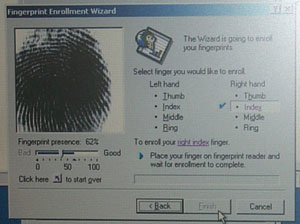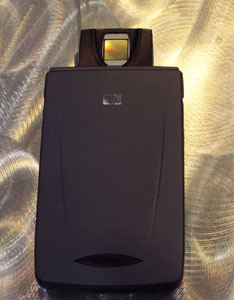Comdex Fall 2000 Summary
by Matthew Witheiler on November 19, 2000 4:14 AM EST- Posted in
- Trade Shows
Biometrics
Another technology that had a strong showing on the show floor was the emerging field of biometrics: electronic security that identifies users in a biological manner. This field of technology has come a long way since its infancy just a few years ago. No longer are biometrics devices unreliable and costly, but many of the products we saw on the show floor were easy to use, very secure, and priced competitively.
In the field of security there three items that comprise the most secure system one can have. These items are represented by points on a triangle aptly named the security triangle. The security triangle is composed of: what you know, what you have, and who you are. By far the most common security method incorporated in electronics today is based off of the "what you know" apex. This part of the triangle is used in conventional security devices such as passwords, PIN numbers, and codes. The item on the security triangle, "what you have", is analogous to having a key to a room. Entrance is only granted if the user has a physical object, such as a key. ATM's take advantage of both this method of security (you ATM card) and the "what you know" apex (your PIN number). Biometrics attempts to take advantage of the final apex of the security triangle: "who you are." Largely left untapped, this method of security is perhaps the most secure, as no one can physically be you. Passwords can be cracked and keys can be lost, but physical aspects of your body will never go away.
The form of biometrics that seems to have caught on the most is finger print recognition. Using any digit of a user's hand to identify the user and allow access, this form of biometrics is both reliable as well as cost effective. We saw quite a few varieties of finger print security devices, each one only taking minutes to train and seconds to recognize the user. Below you will see both a laptop implementation of this technology (PCMCIA devices are also available) as well as a PDA implementation. Naturally, desktop models are available as well that offer extreme ease of use, such as the incorporation of the scanning device in the thumb location of a normal mouse..

Another, more expensive form of biometrics is iris scanning. Each person's
iris, the colored part of the eye, is unique, meaning that this feature
can be used for identification. Irisscanning systems are generally much
bulkier and much more expensive, but also much more reliable. One company
we saw had an iris scanning demonstration setup, where we were actually
able to test out the capabilities of this technology which they hope to
incorporate in ATM systems in a few years.
Ideally, the most secure areas will incorporate all three points on the security triangle, having some type of biometrics device coupled with a physical key as well as a password. This may be an overkill for personal computers, but may prove to be invaluable in areas of high risk. For the personal computer user who just wants some added security, replacing a password with a finger print detecting device seems very attractive.













0 Comments
View All Comments